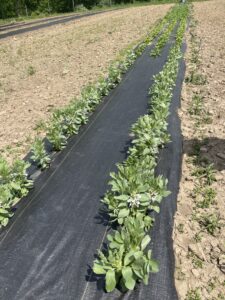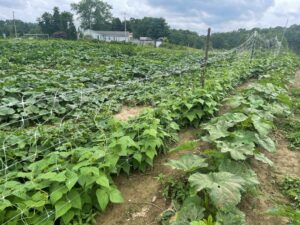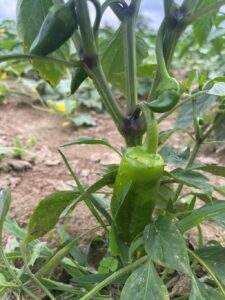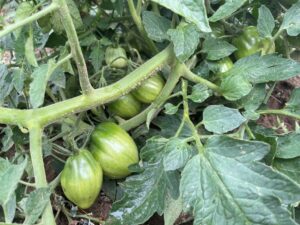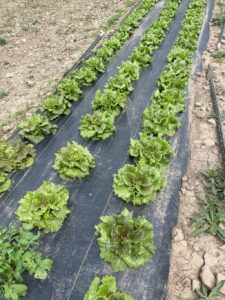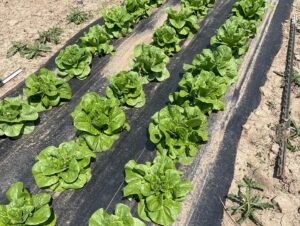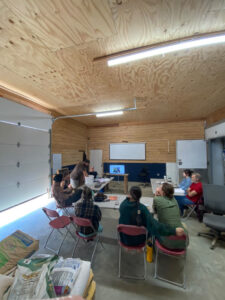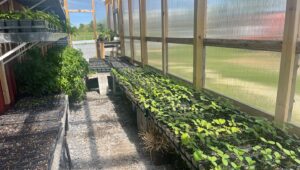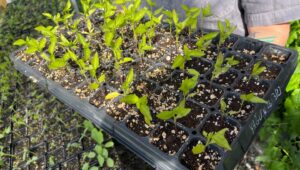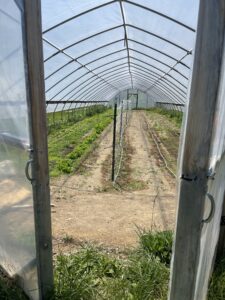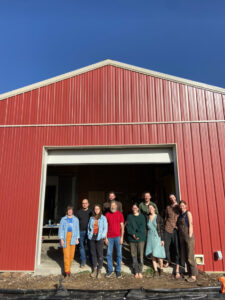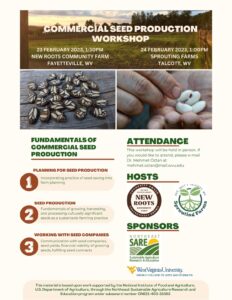Final report for ONE21-403
Project Information
This project explored the viability of commercial seed production as a farm practice for small farmers in West Virginia. In the end, partner farmers located in Morgantown, Fayetteville and Talcott produced seeds that were worth $2,790, $412 and $294, respectively. If they were able to deliver all of the seeds for the weights given in their contracts, they would be able to make $4,420, $1,840 and $1,695, respectively. We concluded that effective communication between the seed grower and seed company, tending plants and observing pest and disease signs closely, blocking weeds with agriculture cover and/or regular weeding to promote plant health improved seed yield of and income from each crop.
We also concluded that:
- Choosing seed crops that takes less space on a small farm, where market farming is also practiced, improves seed yield overall income per area/row space.
- High quality lettuce seed, which is an in-demand seed across the U.S., can be grown in high tunnel in West Virginia.
- It is possible to grow high quality arugula seed, which is another in-demand seed across the U.S., in field conditions in West Virginia.
- We need further efforts to closely look at how we can improve seed yield of dry seed crops such as arugula and lettuce.
- Eggplant seed can be grown in high tunnel in West Virginia to minimize labor and supply cost both of which would be high for field grown eggplant seed crops.
Further study is needed to take a closer look at how to improve seed yield of seed crops specifically in high tunnel conditions, understand ways to reduce labor hours needed to grow each seed crop in field conditions, and help farmers focus more on analyzing finances of growing seed crops so that they can reduce the number of varieties they grow and improve income from the varieties and seed crops that perform better.
Throughout the project, we held farm visits that involved field tours, on-farm demonstrations for growing seeds, seed processing tools and financial and sustainability benefits of growing seeds. In addition, PI of this project prepared a document titled Fundamentals of Commercial Seed Production in West Virginia that focuses on place-based tips and insight for growing seeds in the state, and that will be accessible online at https://twoseedsinapod.com.
Main objectives of this project were to:
- Work with the partner farmers to grow and maintain selected seed crops of tomato, pepper, bean, squash, lettuce, arugula, okra and eggplant in open-field and high tunnel conditions;
- Work with the partner farmers to produce high quality seeds that meet the minimum federal seed germination and commercial seed standards;
- Work with the partner farmers to evaluate the seed yield of each crop for profitability;
- Communicate with the partner farmers for the successful completion of commercial seed production contracts;
- Improve the productivity of the partner farmers and the economic viability of their farms through increasing land use by commercial seed production as a financial incentive;
- Work with the partner farmers to steward regionally-adapted heirloom seed varieties and other culturally significant seed varieties, carry on the cultural and agricultural traditions associated with seeds, and engage other farmers and community in their respective networks for saving and growing seeds;
- Give on-farm demonstrations and workshops for seed saving and commercial seed production, promote project progress via social media and prepare a commercial seed production manual specific to West Virginia.
Profitability of growing seeds for farmers depends on a variety of issues, including understanding how to improve seed yield for a seed crop per given area or row length of production. While seed yield depends on a variety of parameters such as direct-seeding vs transplanting, fertilizer use, variety, altitude, farmer's experience level, labor hours and may vary from one location to another, regardless of the hardiness zone, seed yield data give critical insight to seed growers, for field and financial planning. Despite this importance, seed yield data is rarely publicly available. As a seed grower, I have been compiling seed yield data for over a decade now to inform my own practice and other seed growers, and this project helped me collect further data for some of the commercially popular seed crops in West Virginia settings. This data will give the growers in West Virginia a chance to reflect on how much resources and labor they would need to take over seed contracts in future. This project is place-based; however, data we collected and the experience we collectively gained will also help inform decision making process for other seed growers in other places.
Other than a handful small seed companies, big seed companies in the U.S. usually work with seed houses that sell seeds in bulk, large-scale growers who own substantial acreage of farmland or outsource their seeds from other countries to sell those seeds through their catalogs. While these practices increase those companies' profit margin, they reduce the chances for American small growers to make growing seeds profitable. On the other hand, there is a growing demand from small farmers to adopt sustainable seed saving practices and to make growing seeds for small seed companies make financially viable for them. This project allowed me to work closely with a group of small farmers in West Virginia, where resources are very limited, to explore their needs and better understand the economics of growing seeds at a small scale.
In early 2021, I distributed an online needs assessment survey (attached to my proposal) to WV’s small farmers to better understand the needs of and evaluate the interest among the state’s small farmers to grow seeds as an economic opportunity. I asked the 24 respondents why they never explored growing commercial seeds. Among the 17 people who answered this question, 13 of them said that they were not aware of this economic opportunity, they didn’t have the network to connect them with seed companies, or they don’t have the resources/training needed. Most importantly, 18 out of 24 farmers expressed interest in growing seeds for the commercial seed market that would also advance their sustainable farming practices.
The farmers’ responses were consistent with the observations I have made since arriving in WV in 2018. In a conversation with April Koenig, co-owner of Gaea Farm (Lindside, WV) and the executive director of Sprouting Farms (Talcott, WV), she stated that “Seed saving and generally more regenerative practices are definitely part of the direction we are looking to go with our practices. We are trying to figure out how we can produce higher volume and quality farm products.” Encouraged by Koenig’s statement, in 2020, I remotely did a pilot study with two farms (Mockingbird Hill Farm in Morgantown and Sprouting Farms in Talcott) in the state to grow tomato and bean seeds for our seed company’s catalog. This pilot study generated an income of $900 for the farmers while it also let them save seeds, a new skill that will help them advance their sustainable farming practices, preserve regionally-adapted seeds, reduce their dependence on hybrid seeds, and decrease their overhead costs.
In our pilot study, I identified the problems that reduced the quality of the seeds that farmers delivered to us. These problems included low seed yields, lower-than-ideal germination rates, moldy seeds, seeds that weren’t clean, and problems with packaging for delivery; these issues require experience to be resolved. Farmers also need help in identifying which crops can potentially be more profitable and how they can improve seed yields without changing the production scale in future.
This project gave the partner farmers the opportunity to grow and harvest commercial quality seeds for a variety of annual vegetable seed crops, evaluate their use of land and how growing seeds may fit in their on-farm practices, and have a better understanding of financial viability of growing commercial seeds.
Cooperators
- - Producer
- - Producer
- - Producer
- - Producer
- - Producer
- - Producer
Research
Partner farmers April and Doug Koenig left West Virginia in spring 2022, which means that I wasn't able to work with them for this project. At that time, I communicated with Susanna Wheeler, director of New Roots Community Farm in Fayetteville, WV, to add her to the project as a partner farmer. Toward the project deadline, we also added Evan Morgan, currently the farm manager of New Roots Community Farm, as a partner farmer to have him help with the final stages of the project. We transferred the materials bought for the other partner farmers from Sprouting Farms' farm location in Talcott, WV, to New Roots Community Farm. Wheeler supervised Morgan to finalize project tasks, and she was also personally involved with the tasks throughout the growing season.
Sprouting Farms in Talcott, WV, purchases fertilizer and lime in bulk before every growing season from sources outside the state for the farmers they incubate on their farm. We don't have any commercial sources of organic fertilizer available in bulk quantities in West Virginia. Hence, using the grant funds, we purchased the fertilizer (Ohio Earth Food) and lime which the partner farmers used for this project through Sprouting Farms at cost. Partner farmer Silas Childs is located in Morgantown. In collaboration with Turnrow Appalachian Farm Collective, Sprouting Farms delivered the fertilizer and lime to Childs in Morgantown via one of the produce trucks in the Collective's network. I also made arrangements to have the fertilizer and lime and other materials including trellis and liquid fertilizer previously ordered for April and Doug Koenig transferred to New Roots Community Farm. Tamara Eskridge directly picked her materials up from the Sprouting Farms' office since her high tunnel is on this farm.
All farmers completed project tasks from planting seeds to harvesting and processing them with varying results. I visited the farmers three times throughout the growing season to follow their progress and answer their questions. My communication with Tamara Eskridge was not very effective. Eskridge went through family-related health problems, and it was a challenge to communicate with her via phone prior to my last two visits to Sprouting Farms. It is also true that poor communication infrastructure in rural West Virginia has a negative impact on success and professional development of farmers. I was still able to see her seed crops in the tunnel she utilizes on the farm and observe her progress during my last two visits. Overall, Eskridge didn't utilize her high tunnel efficiently to maximize seed yield from each crop. Hence, seed yield data from her efforts isn't conclusive for high tunnel settings and can only reflect minimum values for each crop.
Silas Childs delivered the seeds he grew for this project on time, early in fall. He also delivered data including labor hours, accurate row lengths and seed yields. Overall, majority of the seeds he grew had germination rates above federal germination standard values identified for commercial seed crops. Bean seeds he delivered had some discoloring due to high humidity levels when the pods were maturing and drying on the vines, a factor that affected seed quality. 2022 was also the year of bean beetle, Epilachna varivestis, damage in West Virginia which significantly affected bean seed yields. Pole bean crop that Childs grew had many hard seeds because of the damage which dropped the germination rate of the seeds down below the germination standards, making this bean unmarketable. In the end, Childs wasn't able to deliver seeds for the pole bean crop that he grew for this project. In addition, some plants for the summer squash (Urgup Sivrisi) failed in the field early in the growing season. Seed yield data from Childs provided reliable results in terms of what to expect from growing the respective seed crops in field settings in our hardiness zone. He estimated the cost for supplies/startup cost (e.g. purchase of t-posts, trellis net etc) needed to grow the crops listed in Table 1 to be $1,000. Note that Childs purchased these items out of his own pocket as an investment to his seed farm but many items he purchased can be used year after year. Childs closely tended his plants, used agriculture cover to block weeds and effectively communicated with me when there were any issues related to diseases, pests, and overall crop performance all of which significantly improved the income he made from the seeds he grew. In total, Childs produced seeds worth of $2,790. If Childs was able to deliver all of the seeds for the weights given in his contract, he would be able to make $4,420. However, note that lettuce and arugula seeds in his contract were 3-4 times more over-priced than average industry prices of these seeds, partly due to the fact that small seed companies pay small farmers more per weight of seeds.
Despite the communication issues I had with her, Tamara Eskridge was able to deliver the majority of the seeds she grew for the project, except the tomato seeds, on time while overall seed yields and quality she delivered were low. Eskridge was also the only grower who delivered lettuce seeds. Unfortunately, Eskridge either kept the seeds for an extended period of time in a room where people were smoking or processed the seeds as she was smoking. Tobacco products may help Tobacco Mosaic Virus spread via seed. Hence, none of the seeds she grew were marketable. While she produced seeds worth of $294, these seeds had to be discarded since they were not sellable. If Eskridge was able to deliver all of the seeds for the weights given in her contract, she would be able to make $1,695.
Susanna Wheeler and her team at New Roots Community Farm shipped their seeds in January 2023. As a rule of thumb, seed catalogs are expected to be ready to announce and disseminate later in fall, when farmers and home gardeners begin planning their seed purchases. First three months of the year is the peak period in terms of seed orders that small seed companies receive. These companies need ample time to test seed germination before they can offer these seeds in their catalogs, and they work with many farmers in each contract season. Hence, New Roots Community Farm was late delivering the seeds; however, they are a new non-profit farm that took over this project right before the beginning of the growing season, when they were trying to accomplish many other projects in 2022. In 2023 growing season, they have more staff to share tasks which will make it possible for me to work with the partner farmer Evan Morgan to make sure that he follows the deadlines in this year's seed contract. In addition, New Roots Community Farm grows produce for farmers' markets, and summer squash is one of the crops they grow. Due to staff limitations, they weren't able to isolate the summer or winter squash seed crops I wanted to assign to them or spare additional labor to hand-pollinating these crops to maintain seed purity. We removed these plants from their growing list, and added one eggplant variety as well as one okra variety as dry seed crops to their field plan. Both of these crops grow very well and are popular in Southeast U.S. and their seeds can be marketed through the seed companies in that region. We also eliminated the bush bean variety to save labor and space on the farm and focused on a pole bean variety for seed production. Eggplant suffered from flea beetle (Altica spp) damage, and they had a crop failure although they initially covered the plants. Okra seeds they grew weren't marketable since they left the seeds in dry pods on the plants, and successive rain events left the seeds moldy in the end. Bean seeds they grew weren't properly cleaned and some of them were discolored due to the same reason as okra but I was able to clean the beans further. In the end, bean and tomato seeds they grew passed the germination tests. Pepper seeds had variable low germination rates. Later I used water winnowing method to see if I can improve the germination rate of these seeds but this method didn't improve the results meaningfully. Hence, pepper seeds they delivered were also not marketable. Due to the abovementioned overwhelming tasks on the farm, folks at New Roots Community Farm couldn't grow neither the lettuce nor the arugula seed crops. Arugula plants were damaged by flea beetle since the crop wasn't planted early enough in spring. In the end, New Roots Community Farm produced seeds worth of $412. If they were able to deliver all of the seeds for the weights given in their contract, they would be able to make $1,840.
August 2022 was very wet in North Central and Southern West Virginia which made it impossible for Silas Childs to successfully grow his lettuce seed crop despite his attempt to temporarily cover the crop with the help of greenhouse plastic and t-posts. However, one of the highlights of this project was that Childs was able to grow a high quality arugula seed crop with a high germination rate (%96). Pulling the plants with their roots intact when the seed pods were mature but weren't entirely dry and curing them in his shed with plastic cover helped him successfully harvest seeds from this crop. When planted early in spring, arugula can mature enough to survive flea beetle damage when this pest arrives as the weather gets warmer in our hardiness zone. Arugula is one of the most popular greens seeds sold by seed companies, and arugula seed growers are in high demand across the U.S.
Seed yield data obtained from the partner farmers for the seed crops they grew is listed in Table 1.
| Crop | Variety | Year | Greenhouse/Field | Location-Hardiness Zone | Row ft/No of Plants | Yield | Labor hr | Contract Price ($) |
| Arugula | Common | 2022 | Field | Morgantown-6 | 96 ft | 2 lb 9 oz | 11.3 | 25/oz |
| Bean, Common | Boşnak Arşın (Bush) | 2022 | Field | Morgantown-6 | 70 ft | 4 lb 2 oz | 8.1 | 20/lb |
| Bean, Common | NT Half-runner | 2022 | Field | Fayetteville-6 | 100 ft | 6 lb 3 oz | - | 20/lb |
| Bean, Common | Pink Tip Greasy | 2022 | Greenhouse | Talcott-6 | - | 2 lb 3 oz | - | 20/lb |
| Bean, Common | Provider (Bush) | 2022 | Greenhouse | Talcott-6 | - | 1 lb | - | 20/lb |
| Lettuce | Lettuce1 | 2022 | Greenhouse | Talcott-6 | - | 1.5 oz | - | 25/oz |
| Pepper, Hot | Jalapeno | 2022 | Greenhouse | Talcott-6 | - | 0.5 oz | - | 40/oz |
| Pepper, Sweet | Bagci Carliston | 2022 | Field | Morgantown-6 | 49 ft | 8.4 oz | 13.5 | 40/oz |
| Pepper, Sweet | Yaglik 28 | 2022 | Field | Fayetteville-6 | 100 ft | 7.8 oz | - | 40/oz |
| Squash, Summer | Costata Romanesco | 2022 | Greenhouse | Talcott-6 | 50 ft | 2.5 lb | - | 60/lb |
| Squash, Summer | Urgup Sivrisi | 2022 | Field | Morgantown-6 | 143 ft | 3 lb 15 oz | 28.4 | 60/lb |
| Squash, Winter | Waltham Butternut | 2022 | Field | Morgantown-6 | 141 ft | 10 lb | 33.9 | 60/lb |
| Tomato | West Virginia Pepper | 2022 | Field | Morgantown-6 | 86 ft | 5.1 oz | 22.4 | 40/oz |
| Tomato | Yalova Heart | 2022 | Field | Morgantown-6 | 83 ft | 4.9 oz | 20.9 | 40/oz |
Table 1. Seed yield data obtained from the partner farmers.
In the end, all of the partner farmers were paid by our seed company, Two Seeds in a Pod, for the seeds they grew. You can find their seed contracts attached to this email.
Wide range of the income that partner farmers made from growing seeds on a contract basis shows that the yield and quality of the seeds they delivered were variable. While one growing season isn't enough to come to a conclusion about the profitability of commercial seed production in West Virginia, considering the fact that farming scale of the state's farmers is among the smallest in the U.S, it is clear that farmers need to choose space-efficient crops to maximize the income from per square foot of their growing space. We observed that choosing bush squash varieties rather than vining varieties, crops that grow vertically and that can trellised such as beans, lettuce and arugula would fit in this strategy.
Improving seed yields requires experience. Tending seed crops closely and communicating closely with the seed company representative for questions and discussions improves seed yield, and this was proven in the case of Silas Childs.
Lettuce requires a dry period at the time of seed maturity to produce high quality seeds which can be maintained in high tunnels. Although quantity of the lettuce seeds Tamara Eskridge grew was small, seed quality was visibly high. Further evaluations would be needed to come to a conclusion, however, planting lettuce early in spring and choosing traditional seed varieties which were not necessarily bred for bolt resistance may be an alternative solution to grow lettuce seed outside before the rainy season arrives in our climate.
Flea beetle can give damage to arugula seeds in field conditions; however, if this crop is planted early enough in spring, plants can reach full maturity before the flea beetle population makes a peak so that the seed yield can be maximized. In our evaluations, we concluded that an early crop of arugula can yield high quality, viable seed for this very popular salad greens seed in West Virginia.
It isn't cost or labor-effective to grow eggplant seed crop in field conditions in West Virginia due to challenges with flea beetle. This crop gives its best seed yield and quality in high tunnel conditions.
It is clear that growing, harvesting and processing squash seeds required more labor time than other crops. However, if the grower negotiates to increase the minimum quantity and price per weight of squash seeds they would like to grow for the seed company, this seed crop can be profitable in one season. On the other hand, profitability of growing seeds can only be achieved for small growers who closely monitors and evaluates the supply costs and labor hours needed for and seed yield harvested from a specific seed crop. This goal requires more than one season to reach for inexperienced seed growers.
Based on my experience in growing seeds and working with other seed growers, I was suspecting that fermentation method shouldn't be used to harvest commercial grade pepper seeds since this method consistently yields lower seed yield. Working with partner farmers on this project confirmed this observation, and I will remove this method from our practice and inform seed growers to do so in future. Instead, seeds should be physically taken out of the peppers to be washed and dried for high germination rates.
As a small seed company co-owner, I am already aware that we need to price seeds without compromising the labor of small farmers we work with or our budget. On the other hand, once Childs and Eskridge delivered their arugula and lettuce seeds, respectively, I realized that the contract prices were substantially higher than the average industry standards. This project not only helped adjust the optimal prices a small seed company can pay for these dry seeds while keeping them fair for growers but it also helped me improve seed contract language for practical situations that involve dirty, moldy and unmarketable seeds. You can find the updated version of our seed contract template attached.
Education & Outreach Activities and Participation Summary
Participation Summary:
I used social media (primarily Instagram) through our seed company's accounts (@twoseedsinapod) to promote our activities throughout the project.
In 2022 growing season, I visited all partner farmers three times. My activities involved walking them through growing, saving, harvesting and processing seeds, using seed saving tools such as seed screens that I brought with me for the workshops, fundamentals of fulfilling seed contracts, economics of growing seeds, stewardship of culturally significant seeds, and racism and discrimination in seed industry.
I met the partner farmers at New Roots Community Farm (Fayetteville) on 23 February 2023 for outreach purposes and held a workshop/presentation to give a summary of the entire process of commercial seed production and answer farmers' questions. This was also an outreach event, and 9 farmers, including the partner farmers, participated in this workshop. I also gave the same workshop at Sprouting Farms on 24 February (Talcott) to 3 farmers. Unfortunately, partner farmer Tamara Eskridge didn't participate in this workshop due to health reasons. Sprouting Farm's current management wasn't responsive to my request of reaching out to other farmers in their regional network as well. I also found out in 2022 that the other partner farmer, Silas Childs, is place bound and was not able to travel to join these workshops due to private reasons.
In addition, I prepared a document titled "Fundamentals of Commercial Seed Production in West Virginia" which is partly based on the results and experience from this project but also compiles practical tips and knowledge based on my previous experience and work with seed growers in West Virginia and other states. This document provides general information about seed production and also focuses on state-specific information. The document will be disseminated via our seed company's website (https://twoseedsinapod.com) and social media as well as via email to partner farmers and their respective networks.
There aren't any non-white commercial seed growers in West Virginia. In summer 2023, I am hoping to give a presentation to the Black farming community in Valscreek, McDowell County, with the hope to incubate and promote Black seed growers in West Virginia.
Learning Outcomes
Farmers reported changes in knowledge and skills for the areas listed below:
- Differences between open-pollinated and hybrid seeds
- Importance of culturally significant seeds, and how race and culture plays an important role in food and seed justice
- Understanding the differences between vegetables' edible maturity and seed maturity cycles
- Saving and processing seeds of commercially popular seed crops for ready-to-sell conditions
- What seed yield means and how it can be improved
- Hand-pollinating and isolating seed crops, when necessary
- How to fulfill seed contracts
Project Outcomes
This project was very helpful for me to better understand how the functional dynamics of a farm can affect the ways in which growing seeds by that farm is adopted. These dynamics depend on whether the farm is a non-profit farm or privately owned or if growing seeds is the farmer's only practice or one of many activities on the farm. New Roots Community Farm is a non-profit farm and their team of farmers need to oversee a variety of projects including but not limited to growing produce for farmers' market, writing grants to fund the farm, leading community outreach projects. Taking over a new project such as seed production was a big challenge for them in the beginning. However, they learnt the fundamental skills for growing seeds which became a new source of income for them. In addition, now that we mutually understand how we can work together without overwhelming them, we can focus on maximizing seed yield and the income from the seeds they will grow in 2023.
After the workshop I gave in February 2023, in an email conversation, partner farmer Evan Morgan wrote:
"It was wonderful to meet you last week, and to hear about some of the work you are doing. I am thoroughly enjoying the seed growers manual you put together as well. There is a lot of useful info in there."
and he added:
"I really like growing biennials or winter annuals to seed, so would be open to trying Beets and Turnip for you as well, as a 2024 crop. Beets in my experience might need to be grown out to seed in a tunnel, as they ripen indeterminately, and seem to be prone to moldy/less viable seed."
Morgan is enthusiastic about continuing growing seeds as a practice, and I will closely work with him in 2023 growing season. This time, I took a step back and assigned him two pole bean varieties to grow so that I can closely work him on improving the seeds yield for this relatively easy to grow annual crop. It is evident that he would like to grow more challenging biennial seed crops in future so once he successfully fulfills this year's seed contract, I am hoping to work with him on this more challenging task.
Seed saving is usually an after thought as a sustainable practice for small farmers. I believe that helping farmers at New Roots Community Farm understand the importance of seed sustainability will not only help them spend less on seeds but also it will improve the performance of their crops by saving seeds from the best plants for successive farming seasons. In addition, they have access to community through their community projects. They will demonstrate seed saving at the community events they will hold on the farm which is especially a great outreach activity for younger community members to understand sustainability.
Communication infrastructure is one of the most significant challenges in professional life in West Virginia. Poor internet and cellphone network in rural parts of the state especially affected the ways in which I wanted to communicate with one of the partner farmers, Tamara Eskridge. This project once again proved how effective communication is important for seed growers to make the most income out of seed contracts. When phone communication is challenging, it is critical to effectively communicate via email so that both the seed grower and seed company can answer questions throughout the growing season, find solutions to pest and disease problems and work together on improving seed yields. While this project gave us great insight in terms of seed yields that can be obtained in field conditions, we need to further assess yields in high tunnel settings. It would be wise to do this with dry seed crops such as lettuce to use growing space in high tunnel efficiently to maximize the income from this space.
Seed yield data is rarely publicly available. This project provided great insight into seed yield data for some of the popular commercial seed crops. Data we obtained will not be only useful for the farmers in West Virginia but in other locations across the country for planning for seed contracts. We need to widely publicize data as such to create an equitable, democratic seed industry in which small seed growers have difficulty accessing information.
It was great to see that it is possible to grow high quality arugula seeds here in West Virginia in field settings. Partner farmer Evan Morgan's enthusiasm about growing biennial seed crops, which are also in-demand dry seed crops like arugula, is encouraging to potentially apply to a two-year grant to explore commercial seed production of biennial crops in West Virginia.
The document I prepared to discuss the fundamentals of commercial seed production in West Virginia will be electronically available which makes the dissemination of the document very easy. Hence, not only the farmers in the state but also farmers in the Appalachian Region with similar growing/climate conditions will benefit from this source of information. In my experience, documents as such stimulate further discussions and project ideas, and can be improved and expanded upon farmers' needs. Hence, I am planning to update the document in future.
